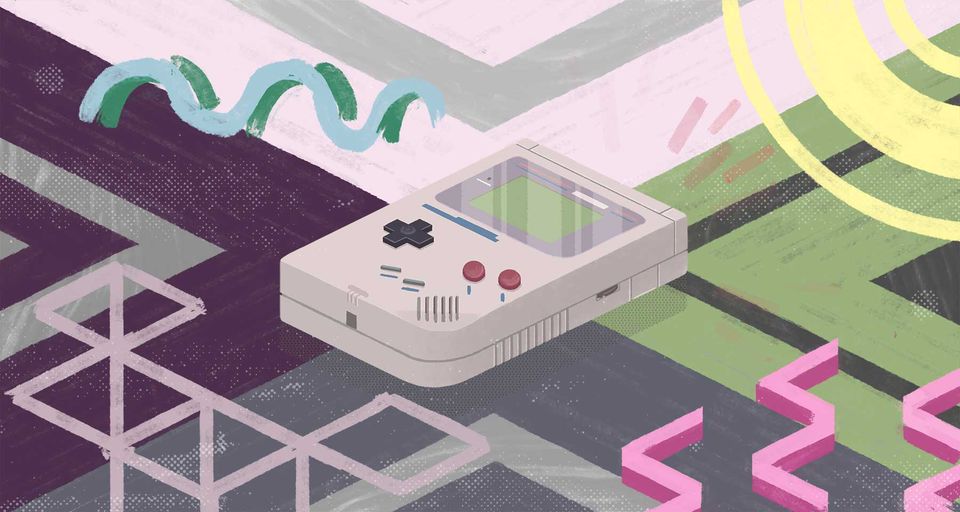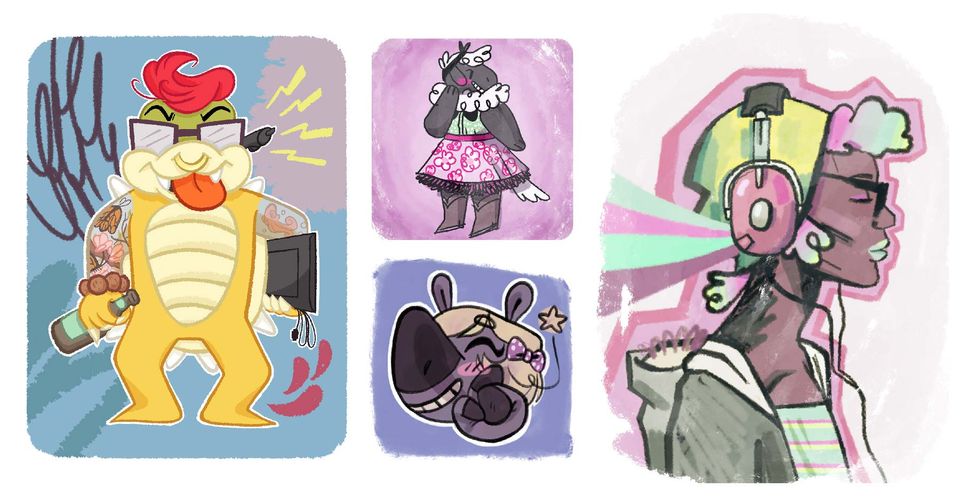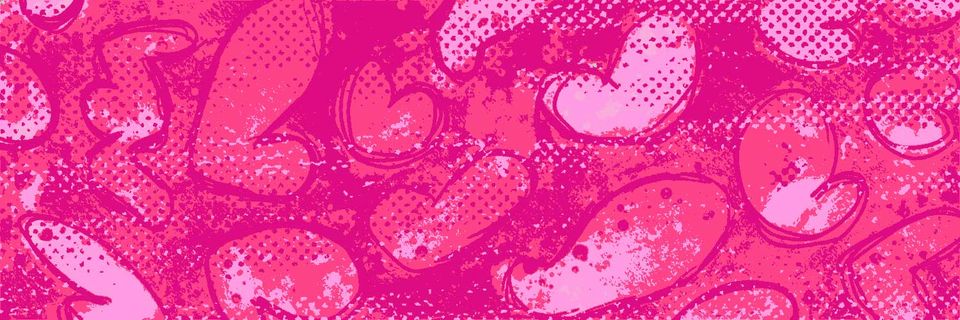Artist Spotlight: Dale O'Flaherty
Website Editor • February 26, 2020
Everyone’s work is deeply idiosyncratic: in our regular Spotlight segment we explore artists’ experiences and inspiration to understand what defines and inspires their unique styles.
Can you give us a brief background on yourself?
I've always been drawing from a very young age but it was never something that I thought of pursuing as a career, so I didn't study art or design in college. I actually have a degree in Science. It was during my undergrad that I kind of got back into drawing and making art. I was reading a lot of webcomics at the time and became aware of a community of artists who were making autobio comics on LiveJournal. I decided to make some of my own and to my surprise people quite liked them. I eventually ended up getting a Wacom tablet for myself as a graduation present (before this I was just drawing the comics in a sketchbook and then scanning them in). I don't think I was even colouring my comics at this stage I had very little idea of how I would go about doing that. I remember sending an email to James Kochalka (best known for his long running daily diary comic series American Elf) asking him if he used different colour inks for his lines because I didn't realise that you could change the colour of your inks after you'd scanned them in. So, I got myself a Wacom tablet and set about teaching myself how to use graphic design software. At the time I was using a program called PaintTool SAI, which is a cheap lightweight painting program. It's actually still quite popular among young artists, and people are still making incredible work with it. I used Manga Studio for a little while afterwards, but now I use Adobe Photoshop for pretty much everything. I was really intimidated by Photoshop and avoided trying to learn how to use it for quite some time, but the shortcuts are quite similar to Manga Studio so it wasn't as scary to learn as I thought it would be. I did do a diploma course in graphic design to get some formal adobe suite training and I did a fine art course for all of about 3 months, but besides that I’m more or less entirely self taught.

What kind of influence does your location have on your career?
Since I'm not formally trained in art or design I don't feel like I have a lot of connections in the Irish design community. Most of my friends and peers live overseas. I know only a handful of Irish artists personally. There are good and bad aspects to this. I feel richer for having access to people of a wide variety of backgrounds and I feel like this has made me a better artist, and a more thoughtful person. But also, I definitely feel very disconnected from the local arts scene.
What is your process like when combining traditional and digital methods?
I generally use my sketchbook to figure out what I want to communicate first before I go into Photoshop. For whatever reason, it feels more natural for me to iterate through different ideas and concepts on paper. But recently, I’ve been experimenting with colouring sketches digitally that feels like a good mix of both methods. I will sketch something out then take a picture of it with my phone then bring it into Photoshop. I usually mess with the levels a bit to make it a bit brighter. Then I’ll just paint on top of it and mess with layer blending modes and adjustment masks until I have something that I’m happy with.
Could you pick one piece of art that has made a lasting influence on you, and if so why?
Probably the aforementioned American Elf by James Kochalka. He would sit down every day and make a comic about what happened that day, and he did that every day for 14 years. Often his comics were about very mundane things, but they would still be really funny and beautiful. It made the act of making comics very approachable. As far as other artists that influence me, I’m a big fan of Pseudonym Jones, Laura Knetzger, Tom Eccles, Maris Wicks, Sarah Sobole, kittenpillar, Allie Mehner, weja, Sam Davies, Lottie Pencheon, titas antanas vilkaitis, Anna Syvertsson... I love artists that make very bold, clean, and chunky art with interesting shapes and textures.
What skills or techniques are you working to try improve at the moment?
I spent a long time thinking that my art needed to be more figurative to be better (I guess because of insecurity over being self taught), and it was making art really unenjoyable, time consuming, and stressful to make and there would be long periods of time where I just wasn’t able to make anything. So, what I’ve been working on is changing how I approach my work and making it more enjoyable, because it wasn’t for the longest time. So, I’ve been making fan art, doodles, and other really goofy self indulgent things. I’ve also changed up my process a lot, I’m trying to be much looser and more experimental in how I do things and I’ve found that’s helped as well.
Can you give our readers a tip or trick you have come across that has made your work a lot easier?
I’d say not to be afraid of experimenting and playing around. Half of my favourite pieces come from just messing around and not worrying about the subject matter or the final image/product. You can always use those techniques you learn on weird experimental doodles later in bigger pieces. No time is wasted if you’re learning something. If I wanted to give some practical advice I would say use adjustment layers and always keep backups of your files. Also, if you use Photoshop I'd highly recommend Lazy Nezumi's
brush smoothing plug in. As well as, any set from Kyle Webster's brush shop.
How can people who are interested in discovering more of your work find it?
My Tumblr is where I post my finished pieces, but I post most of my doodles to Instagram and Twitter and they are both more regularly updated.
Scriba is a revolutionary digital stylus that is ergonomically designed to comfortably fit your hand and uses unique Squeeze-Motion technology. Order here.
Articles

The United Nations has described the disruption to education caused by the pandemic as ‘unparalleled’. At the virus’ worldwide peak in April, it is estimated that over 90% of all enrolled learners, from kindergarten to bachelors and beyond, had their education affected by school closures and the pandemic (UNESCO). For many university students and older children, they have had to adapt quickly to online learning. They can keep in touch with their peers and teachers online and continue their studies, albeit in a highly modified way. As challenging as this may be, this experience will help equip them for a future that is increasingly online. For parents of younger children, they are assuming a new role: their child’s home school teacher. This is in addition to their usual childcare and household duties, their work responsibilities and often emotional and financial worries caused by the pandemic. Stressful? Yes. The good, and somewhat surprising, news? The experts advise that you don’t teach your children - at least not in the way you might expect.

If the recent outbreak of Covid-19 has taught us anything, it's that many adults do not wash their hands effectively. It has never been more important that we support our children to develop good personal hygiene to keep themselves and our families safe. This seemingly easy task can be very difficult for children with fine motor skill difficulties. In this article, we explore some ideas to support your child with hand washing.

Lockdown has brought the digital future into the now. Online shopping, entertainment, education and more have moved from the periphery to the mainstream to, in many cases, the only option. With the necessity of social distancing looking to continue for many months, it appears that this rapid digital revolution is here to stay. This means that life as we know it, in most of its sectors, has changed forever. In order to survive, businesses are having to adapt rapidly, embrace technology and look to the future. Architecture is no exception. There has been a widespread adoption of technology and VR over the past few months in response to the lockdown across all of society. Elderly grandparents who were once resistant to adopt new technologies talk of “Zooming” and have started video chatting with their family members to combat loneliness. Art galleries that were once considered stuffy or pretentious are now pioneers in VR technology, with Google Art & Culture offering tours of London’s National Gallery or the Musee D’Orsay in Paris. These virtual tours deliver art in a dynamic new way that can be far more engaging than regular photos. Critics have applauded the panoramic and immersive views of gallery building and exhibitions which work well for rendering of 2 dimensional art, however impressions of sculpture is somewhat lacklustre. With VR technology, users can enjoy a truly immersive experience in the comforts, and safety, of their own home. The COVID-19 pandemic has served as an accelerant for the arts and entertainment industries to embrace VR.






